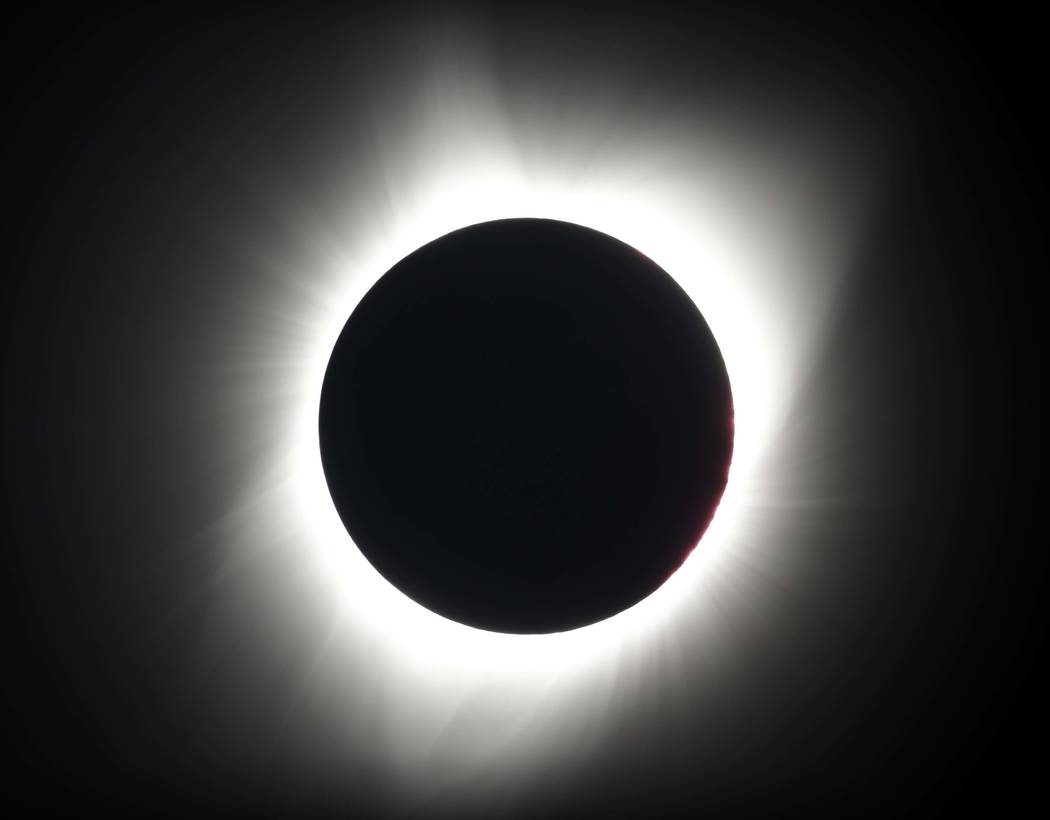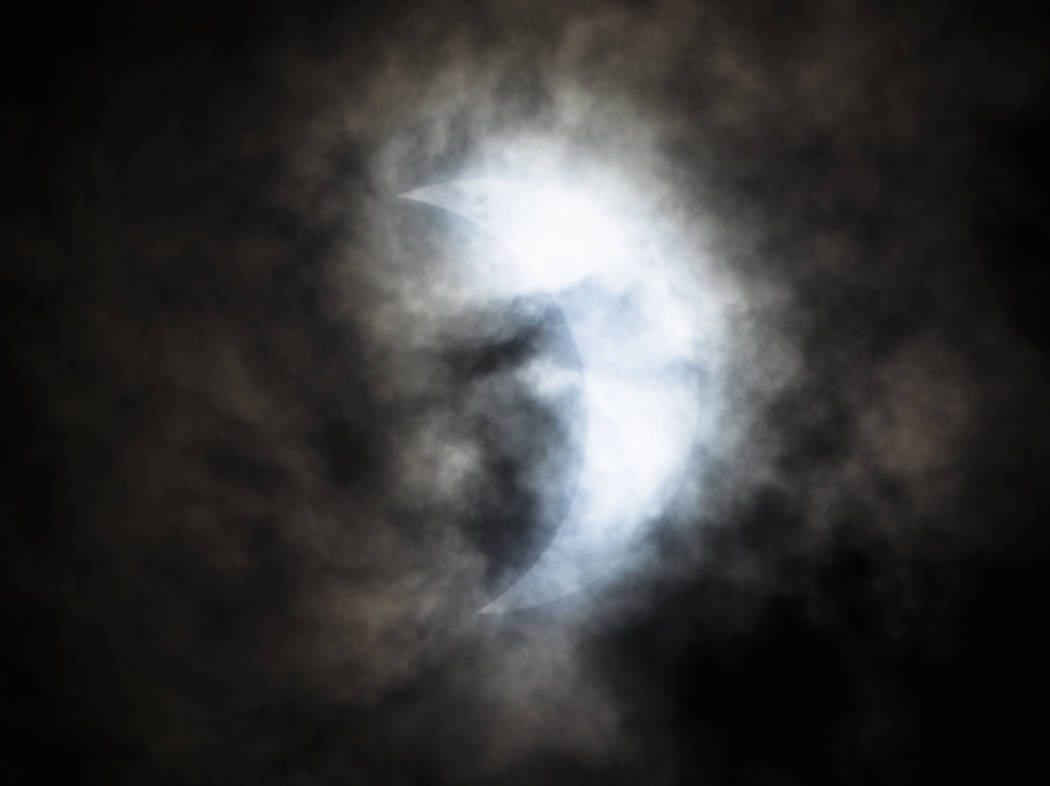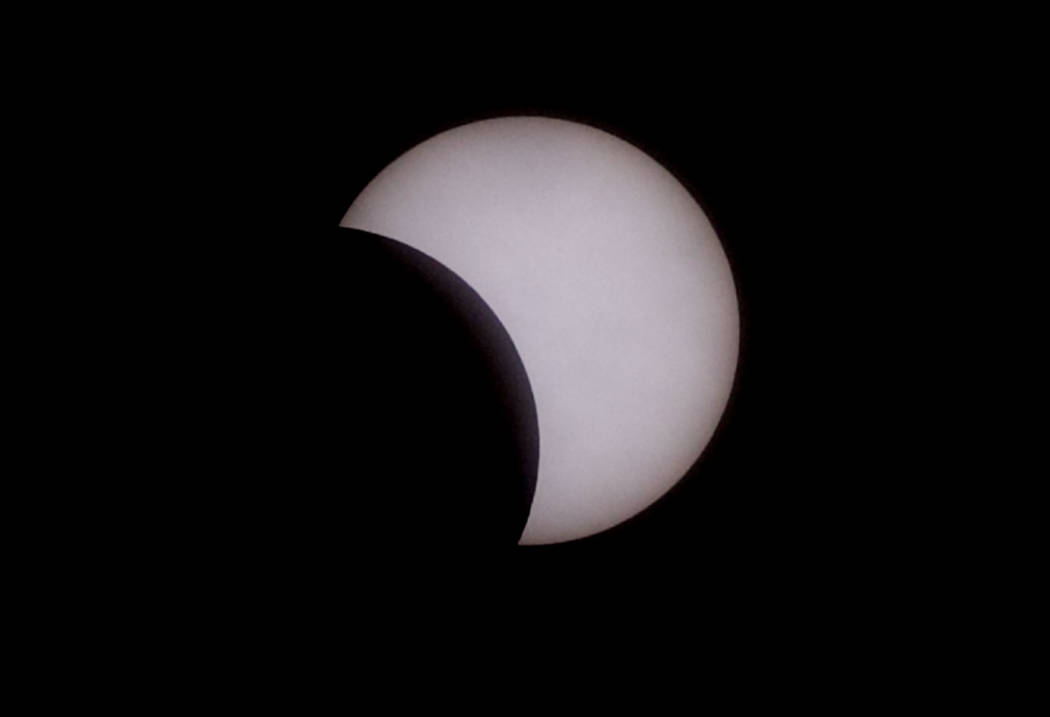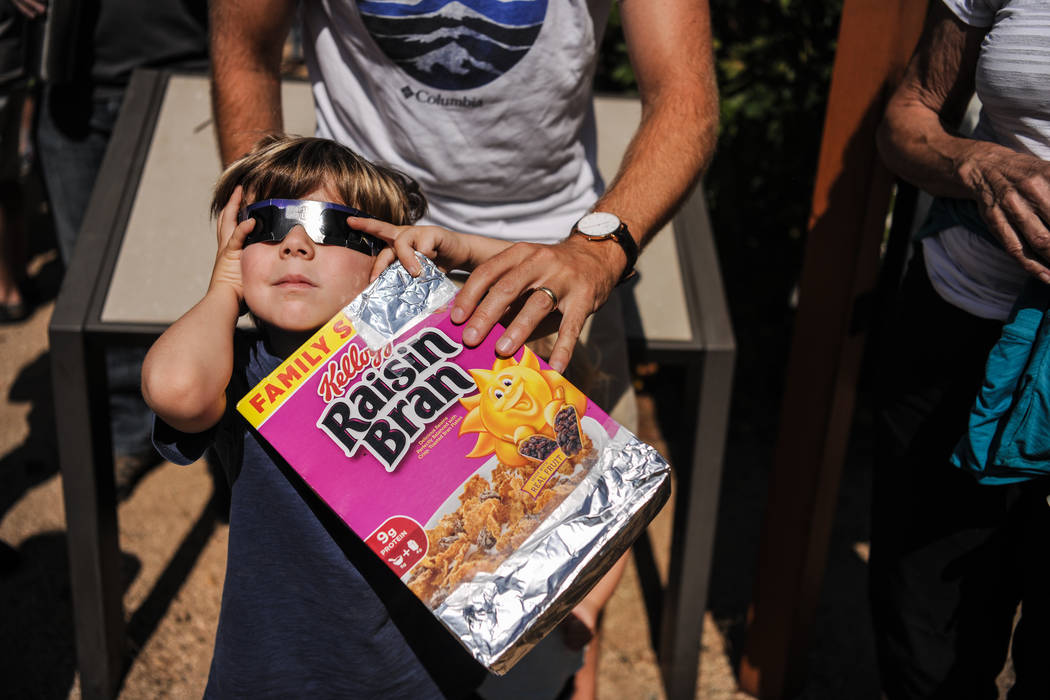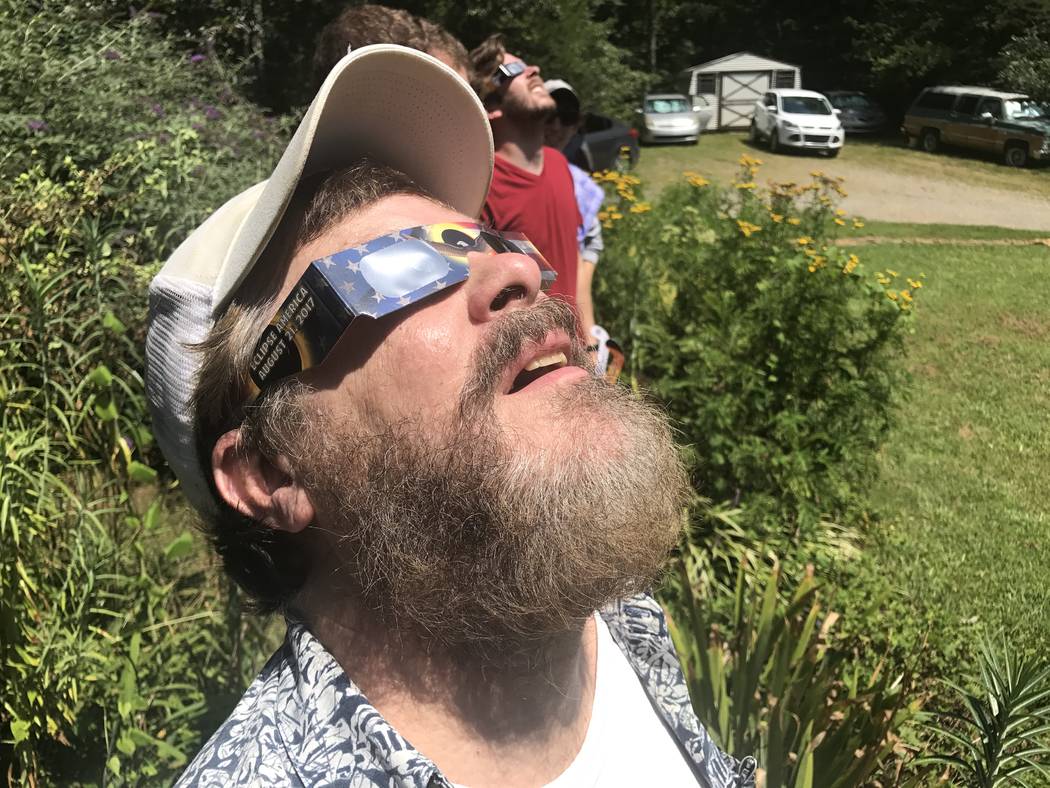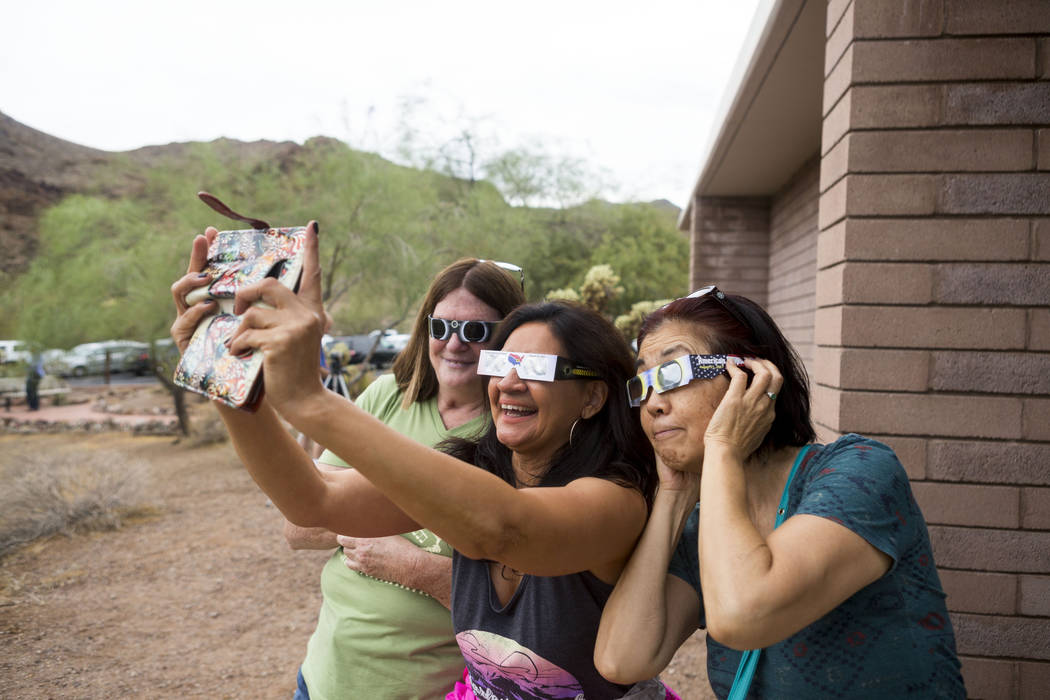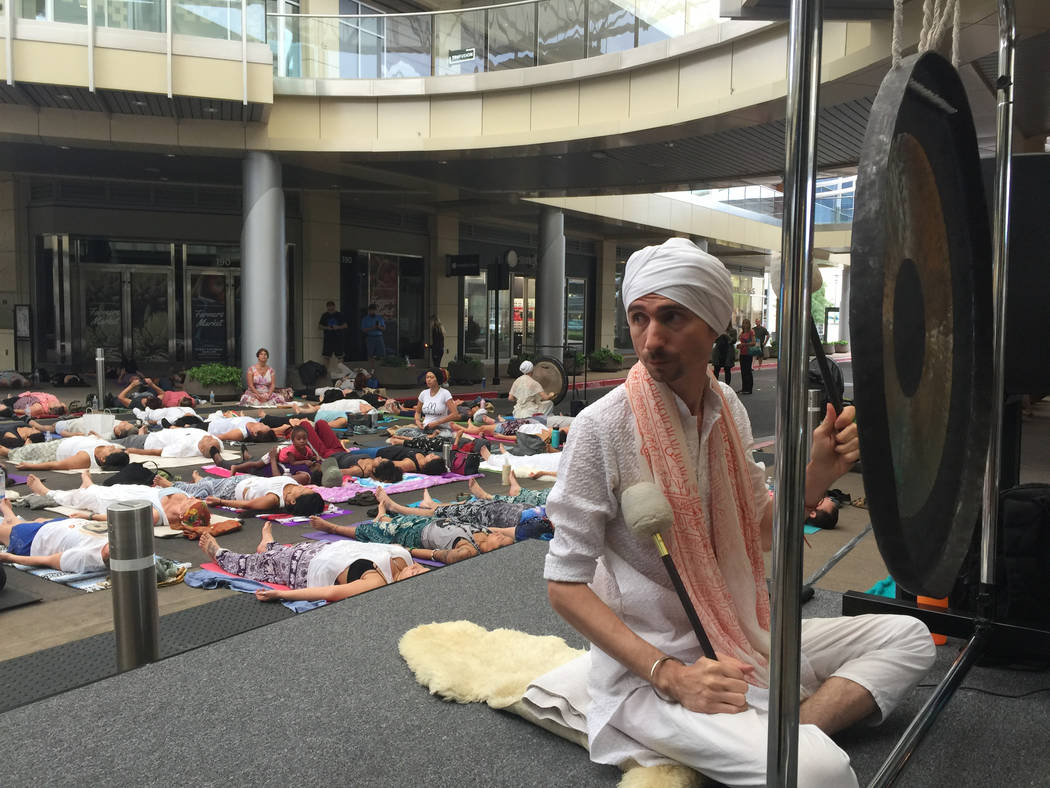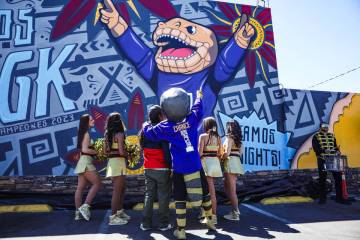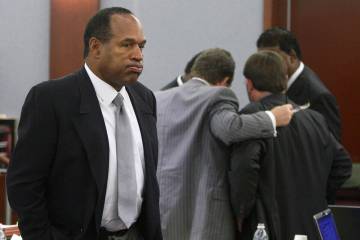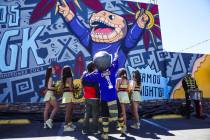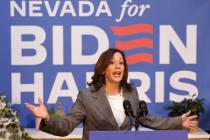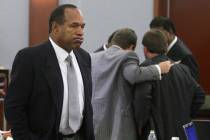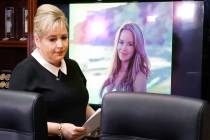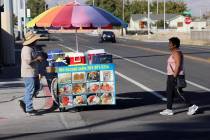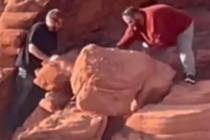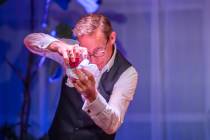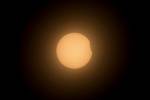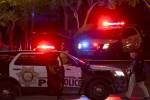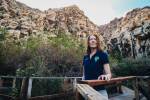Las Vegas gets a glimpse, but eclipse watchers around US get a thrill — PHOTOS
Las Vegas largely lost out on getting a good peek the solar eclipse on Monday, but the viewing wasn’t a total bust elsewhere.
With 70 to 75 percent of cloud cover over the entire valley during, the moon-covered sun was largely blocked by the clouds for most viewers in Las Vegas. Some were lucky enough to be in a spot where the clouds started to clear just as the eclipse was happening.
Las Vegas was in the area of a partial eclipse, with a 72 percent obscurity.
The Review-Journal had reporters covering the eclipse in Oregon, Idaho, Wyoming, Nebraska, Maryland, Washington, D.C., North Carolina and Carson City. Here’s what they saw:
In the path of totality
SILVERTON, Ore. (100 percent totality) — On a grassy field in the middle of a giant Oregon botanical garden, Las Vegan Syd Rabin, 67, set up folding chairs with his family, waiting.
It was dawn — the morning air cool and damp — and Rabin had just driven in from Portland, where his son lives, at about 3:30 a.m. to beat the traffic. He had flown into Oregon from Las Vegas on Saturday.
Here at the Oregon Garden, as the sun continued to rise, Rabin was surrounded by his wife, two children and older sister, who flew in from Los Angeles.
It’s no secret they were excited about the eclipse. But they were also just happy to be together.
“It kind of became a family reunion,” Rabin’s sister, Linda Rabin Maman, 72, said.
They held down their spot as the field around them filled with hundreds of more people, shiny eclipse-viewing glasses in hand.
When the moon finally crossed the sun, the crowd applauded, cheered and whistled. The excitement reached a crescendo as totality hit and the morning sky became dark.
— Rachel Crosby
A view from the bridge
LAS VEGAS STRIP (72 percent totality) — Instead of a moon partially eclipsing the sun, a cloud created its own totality over the sun for about 20 tourists gathered on the pedestrian bridge outside The Cosmopolitan on the Las Vegas Strip.
The bridge was caught between two skies: dark to the north, light blue to the south. At 10:27 a.m., the peak time for eclipse viewing in the valley, some skywatchers gave up on seeing anything other than occasional sunlight peeking from the cloud.
Arlene Stevens, 69, dropped her eclipse-viewing glasses — given to her by a friend back home near Chicago — into her bag and went with her sister to find available slot machines.
“This won’t ruin our trip,” she said. “We’re here to win some money.”
As the peak time passed, attention on the bridge shifted to the cries of Amy Anderson and her group of about six friends and family, all visiting from Nebraska.
The group had left one of the best eclipse-viewing areas in the country for a few days of shows and gambling in the valley. They brought their glasses in case a good view could be found among the rows of casinos and shopping centers.
Their patience paid off, and Anderson wasn’t going to keep the experience to herself.
“You’ve got to see it,” she called out to others walking the bridge over Las Vegas Boulevard. “It’s super cool.”
Anderson offered her glasses to Monazia Smith, of Los Angeles. Smith, in town for her 21st birthday, saw a golden orange sphere through the cloud. The sphere grew as the moon continued on its path.
“Oh, my goodness,” she said. “Oh, my God. It’s beautiful.”
Soon the clouds disappeared. The rain-soaked streets of Las Vegas Boulevard dried and foot traffic returned beneath the bridge.
— Wade Tyler Millward
Time traveling in 143 minutes
SALEM, Ore. (100 percent totality) — By the time I started planning this trip in early August, roundtrip airfare to Portland started at $570. Rental cars started at $1000/day. Hotel rooms, if they were available, cost nearly as much as my flight.
Determined to travel for less, I decided on an absurd, but reasonably affordable itinerary. My Saturday flight to Seattle got in at 1 a.m. I lingered in the airport until 6 a.m. when I caught the light rail to the bus station for a 3-hour bus ride to Portland. I crashed on the couch of a friend of a friend before getting up at 4 a.m. to take the 5:30 a.m. airport shuttle into Salem. I repeated the process in reverse to get home.
The journey was long and inefficient. But it only cost me $300.
The lawn that faces the Oregon Capitol Building was packed with families, photographers and telescope enthusiasts by 8 a.m. A queue formed in front of a woman who waved incense across volunteers’ bodies.
“It’s an Aztec tradition,” she said. “It is for cleaning and purifying you.”
Behind her, her partner rhythmically beat an Aztec drum.
The first disappearance of the sun at 9:05 a.m. elicited a cheer from crowd. As totality neared, observers pointed out the eerie blueish hue in the air, the extended length of their shadows and the suddenly erratic flight patterns of the birds. We pulled our sweaters back on, surprised by the swift drop in temperature.
When totality finally occurred at 10:17 a.m., the crowd erupted into applause, expressions of awe and fits of laughter. Two minutes later, we let out a unified cheer when the sun peaked back out from behind the moon.
It was impossibly beautiful. I felt like a time-traveler— capable of experiencing the passage of morning to night to morning again in only 143 minutes.
It was absolutely worth the ridiculous commute I took to get there.
— Janna Karel
Time for a new T-shirt
COLLEGE OF SOUTHERN NEVADA, NORTH LAS VEGAS CAMPUS (72 percent totality) — Andrew Kerr is going to need another T-shirt.
Kerr, the planetarium manager at the College of Southern Nevada, began preparing for the total solar eclipse in 1999 when he bought a shirt with the words: “Don’t be left out of the dark. Total eclipse 2017.”
The shirt is still tucked away in a drawer at his house.
“Of course I’m disappointed,” Kerr said Monday morning as clouds hovered over the college and rain poured down. “I would have loved to have been able to actually see it from here.”
Kerr might have a chance to redeem his luck in 2024 — the next time a total eclipse will cross the United States.
“Sometimes it really feels like, the greater the astronomical event, the more likely it is for there to be clouds for it,” Kerr said, adding that early morning cloud cover occurs only 10 days a year in Las Vegas.
“This is a very rare thing,” he said.
Kerr was buoyed, however, by the number of people who braved the rain to wait in line for a pair of solar eclipse viewing glasses. He estimates 3,000 people showed up.
“It’s actually really, really incredible how many people are standing out here in the rain, hoping to catch a glimpse of this solar eclipse that we may not even get a chance to see at all today now,” he said.
Nancy Pudelwitts, 66, of North Las Vegas was one of them.
She made her way inside however, for a watch party of the NASA livestream. The college had to open up a second room to accommodate for the weather and all the hopeful eclipse watchers.
“Mother nature took over. There’s nothing we can do about it, so this is the next best thing,” she said. “We’re just glad to be here and see it, because it is a part of history.”
— Natalie Bruzda
Made for this moment
CARSON CITY (83 percent totality) — The Jack C. Davis Observatory was created for events like the rare total solar eclipse that crossed the United States on Monday.
The observatory, opened on May 15, 2003, the day of a lunar eclipse.
“We’re really into eclipses here,” said Robert Collier, the observatory founder and a retired director of the facility. “People realize how important it is because it’s a total eclipse.”
Hundreds of people flocked to the observatory, part of Western Nevada College, to get high-tech views of the solar eclipse. Options for viewing were plentiful: In the comfort of an air-conditioned classroom, the observatory’s telescope showed the eclipse on a screen alongside the NASA program.
Outside, telescopes were set up. The observatory also offered old-school tools for viewing: boxes with a pinhole for viewing and glasses for watching as the moon covers the sun.
The observatory recorded the eclipse, but Gary Nelson, a photographer from Carson City, brought his own gear.
“People can look back at this and say these people were here,” Nelson said.
As the eclipse covered the sun, attendees stood in line to take a turn peering through telescopes. Some moved back and forth between the outside viewing area with telescopes and the inside of the observatory with streaming video. Collier helped people look into a telescope.
“It was pretty cool,” said Mike Lucas, a Gardnerville resident. “They have great telescopes.”
Tom Herring, director of the observatory and a physics professor at Western Nevada College, said that the 83 percent coverage in Carson City drew a good turnout.
“I thought surely everyone’s going to Oregon and Idaho, but we have quite a crowd here,” he said.
— Ben Botkin
Total darkness and a traffic jam
RIGBY, Idaho (100 percent totality) — Cheers rose up from the crowd of eclipse chasers in Wes and Suzanne Woods’ field as night fell in the middle of the day.
Clear skies greeted the roughly 150 people who paid $100 a car to rent a camp space on the Woods’ five-acre spread about 650 miles northeast of Las Vegas. Some came from as far away as Austria, France and the Netherlands.
It took about an hour for the sky to dim and the temperature to fall, but the final dip into deepest dusk arrived with startling speed. Suddenly the sun was a silver ring, the moon its dark center.
The Woods’ chickens disappeared into their coop to roost.
Sheena Cox, Wes and Suzanne’s daughter, said they got inquiries from as far away as Hong Kong when they listed their place on Airbnb. They sold their 53rd and final site on Saturday.
Eclipse watchers began to file out of the temporary campground even before the moon had finished its trip across the sun.
The quick departure didn’t help. The highway south toward Idaho Falls was bumper to bumper, stop and go.
— Henry Brean
From 305 to thousands
GLENDO, Wyo. (100 percent totality) — Thousands of umbraphiles and eclipse chasers cheered as temperatures dropped and day turned to night for 2½ minutes under clear Wyoming skies.
Eclipse viewers parked on a vast lakeside meadow at Glendo State Park a few miles off the totality centerline.
Wyoming tourism officials estimated 600,000 visitors, roughly doubling the state population for a day. The town of Glendo, population 305, was overwhelmed by the numbers and visitors spent hours stuck on Interstate 25 between Denver and Casper, Wyoming.
Eclipse viewers of all ages met new friends and children chased locusts and threw footballs in the field as the moon slowly moved across the face of the sun and turned the entire horizon into a 360-degree sunset.
The next big total eclipse over the United States will extend from Texas to Maine in April 2024. Northern Nevada will get its own eclipse in August 2045.
— Richard N. Velotta
A reason to visit Nebraska
LINCOLN, Neb. (100 percent totality) — Monday was the first day of the University of Nebraska-Lincoln’s fall semester, but that didn’t stop thousands of students from escaping class to view the solar eclipse.
The total solar eclipse hit Lincoln about 1:02 p.m. local time, and lasted for about 90 seconds. The university made sure students were prepared for the experience, setting up stations to hand out viewing glasses and blasting music near the City Campus Green Space — including songs like Bonnie Tyler’s “Total Eclipse of the Heart” and The Beatles’ “Here Comes the Sun.”
Maya McIntosh, a 19-year-old sophomore veterinary science major, set up towels on the green space hours before the eclipse’s moment of totality, staking a position to view the celestial event. By 1 p.m., she was seated among hundreds of other crowded onlookers.
“It’s kind of crazy,” she said. “It’s really cool for the state because nobody comes to Nebraska.”
Woubeshet Ayenew, 47, traveled from Minneapolis to Lincoln with his wife, Rahel Melesse, and their two sons. This was their first time in Lincoln, but Ayenew and his wife thought of it as a once-in-a-lifetime educational moment for their children. The family couldn’t find any available hotel rooms in Lincoln, and would travel over 50 miles to spend the night in Omaha.
Ayenew’s 8-year-old son, Tebarek Woubeshet, said it was worth the six-hour drive.
— Bailey Schulz
Getting a peek
LAS VEGAS (72 percent totality) — Children at Keeping the Youth Educated Early Care and Education Center in Las Vegas witnessed a first in their lives — “a big orange spot.”
The group of eight 3 to 5-year-olds decorated paper plate masks with colorful scribbles in the morning before their instructors attached special eclipse sunglasses and secured it around their heads with a rubber band.
“Remember, no peeking,” said director of the center, Amy Robinson. “It’s just like Christmas — there’s no peeking. If you touch your glasses you have to go inside the classroom.”
Children lined up and held each other’s hands as they walked through the door and into the outside play area.
“I can’t see anything,” said 3-year-old Ethan Clayton-Chapparo.
“You have to look up,” Robinson said as she adjusted another child’s head.
The clouds cleared up just enough for the sun peeped into view the solar eclipse.
“It was a really neat surprise to see,” said Emma Pease-Byron who came with her 3-year-old daughter Lilah. “I thought the masks were a great idea because they really covered their eyes and made it safer for them to view.”
Robinson secured 33 solar eclipse glasses more than a month ago and gave five away to pleading parents. She almost didn’t want through with the activity due to safety reasons.
“I really emphasize safety first,” Robinson said. “At the same time I think it’s important that children explore. Kids may not remember this, but this could light the flame that sparks their interest in space or science.”
After the activity was over children were given moon pies to commemorate another first in their young lives.
“I had a lot of fun,” said 3-year-old Gisele Oseguera. “It was dark at first, but then I saw the moon and I was surprised. I thought it was cool because it was orange. I won’t forget it.”
— Sandy Lopez
Clearing bad karma
SUMMERLIN (72 percent totality) — By 9 a.m. on Monday, the gray clouds hovered over Downtown Summerlin, and the yogis had just started to arrive. First, they lined up at the Silver Post store to pick out their free mineral or stone. Then, the close to 200 people dressed in brightly colored yoga pants stretched out, releasing negative energy under the solar eclipse. Their stones charged from their place at the end of each yoga mat.
When the clock struck 10:30, the moon was still making its way over the sun. It was the peak time. White Sage burned. The scent of Palo Santo, “holy wood,” also filled the air.
From the front, instructor Cosmin Mahadev Singh played the gong. The sound vibrated under the canopy. The restful bodies lay, arms and legs outstretched, eyes closed.
“It was almost a godsend there was a breeze, and the sun wasn’t out,” said Staci Maione, a member of the RYK Yoga studio, which partnered with Silver Post, a store that sells items made by 18 indigenous tribes, to help connect the community with their own spirituality.
Cherisha Sookdeo, manager of RYK yoga, said Monday’s 90-minute class represented the cleansing of the mind, body and soul.
“The new moon was yesterday,” she said. “We’re using that energy to cleanse the spiritual body.”
By focusing on a physical workout, as well as an emotional and spiritual connection, the solar eclipse was a way to “clear bad karma.”
“We’re so disconnected from our Earth,” she said. “This helps us to connect again.”
As the group finished, they sang. “Ra Ma Da Sa Sa Se Sohom.” World peace.
— Briana Erickson
Gone in an instant
BRASSTOWN, N.C. (100 percent totality) — In the hills of North Carolina, where a total solar eclipse briefly crossed the westernmost corner of the state, friends gathered to party at a mountain home. After a year of expectations and warnings, guests marveled that the roads weren’t jammed with tourists.
As totality approached, cows were heard mooing and helicopters were spotted crossing the normally empty Appalachian sky. Observers held their phones up to eclipse glasses and squinted to take photos. Sunlight filtered through trees to create crescent shapes on rocks outside. The temperature dropped quickly and noticeably.
When the sun was fully covered by the moon, the glasses came off and exclamations of amazement were heard for the next two minutes. A few stars were spotted. The mountain landscape looked like it does at the first brush of daylight.
Total blackness never came, but it was dark enough for the flash to automatically deploy on phone cameras. Despite attempts, cellphones couldn’t capture the amazing sight.
Then the totality passed, and everyone went inside for lunch.
“This feels like a New Years celebration,” observer David Layfield of Murphy, N.C. said. “You anticipate it, there it is, and then it’s gone.”
— Harrison Keely
Chilling the golf course
DERWOOD, Md., Needwood Golf Course (82 percent totality) — It was a steady Monday as golfers went out onto Needwood Golf Course, a public track in suburban D.C. with gentle sloping fairways lined with pines, oaks and lakes.
The eclipse began a little after 1 p.m. Rick Canta of Rockville brought certified glasses to watch the moon eat chunks out of the sun. He passed those glasses around to everyone who wished to look at the celestial event.
“It’s so exciting,” said Jean Fox, who works at Needwood and came away from the food counter to catch a glimpse.
Clouds masked the eclipse at times, and while the sun dimmed, the biggest thing people noticed was the dip in temperature. Without the glasses, it was difficult to tell that anything unusual was happening.
But those who got to peek from the several glasses being passed around were satisfied with seeing a historic moment.
— Gary Martin
The White House press corps goes dark
WASHINGTON, D.C. (81 percent totality) — Most summer afternoons the space between the White House and Lafayette Park is packed with tourists from across the globe. Monday afternoon, the crowd was sparse. Only a couple of field trips worth of students hugged the White House fence.
All morning the area was subdued. The Metro ride was quiet and uneventful. Street corners where families often hesitate — not sure how to get where they were going — were easy to navigate. Smart tourists headed to the monuments, the Air and Space Museum.
It was the working lunch crowd that figured the White House would offer shade, room and a view to the big moment. Did anyone want to talk to a reporter from the Vegas paper? Don’t kid a kidder.
The White House press corps gathered outside the Brady briefing room and the sticks (the microphones assembled near the West Wing entrance). Small groups of aides left the building and blinked toward the sun.
Every day this White House sets the clock and the local press corps distill the meaning in a snap. But for one hour of one day, the moon walked over the sun and the powers of the universe could do nothing but watch and whisper.
— Debra Saunders
From the safety of the classroom
LOWMAN ELEMENTARY SCHOOL (stuck indoors) — Lou Markouzis made the announcement over the school’s speakers just before 9:50 a.m.
Rain and clouds would force students at Markouzis’s school, Lowman Elementary School, and Manch Elementary School, just next door, to watch a livestream of the historic solar eclipse from the comfort and safety of their classrooms.
“The clouds got in the way,” said 9-year-old Connor Llanes.
UnitedHealthcare of Nevada had donated 1,000 glasses to the schools for the event. The organization bought 10,000 pairs of glasses and distributed them to partner schools or Boys & Girls Clubs across the country.
“It was going to be an amazing event,” said Marianne Roe, science, technology, engineering and math teacher at the school.
But all was not lost. The children got to keep the glasses and many of them stared up at the classroom lighting, testing them out. Fourth-grade teacher Susan Lefave planned to give her class a writing assignment, comparing the special eclipse glasses to a set of three-dimensional glasses she owns.
— Meghin Delaney
Cloudy skies leave traveler ‘bummed’
BOULDER CITY (71 percent totality) — Despite dense clouds and rain, an estimated 600 people packed the Lake Mead Visitor Center Monday morning, hoping the clouds would move out so they could glimpse the solar eclipse.
Linda Larkin of Henderson organized a viewing at Lake Mead, but most stayed home because of the weather.
“I couldn’t stand to cancel,” she said.
Larkin remembers seeing 100 percent totality during the 1979 solar eclipse in her native Oregon, and said she should have gone back there for the rare event.
Some people huddled in the visitor center’s theater, where a NASA livestream showed the eclipse from Oregon.
Charlene Wiesenborn, a retired high school science teacher from Boulder City, was holding out hope for a view.
“We don’t know what nature is going to do,” she said.
The eclipse was slightly visible for a minute or two through special glasses given out at the center.
The visitor center’s log from Monday had entries from as far away as New York. Some people made their disappointment clear in the guest book.
“It’s rainy, I didn’t see the eclipse,” one visitor wrote.
“Cloudy — totally disappointed. Bummed!” wrote another.
Lake Mead visitors would have seen 71 percent totality, had the clouds moved out in time on Monday. The plan was to use a solar telescope on the center’s plaza to safely view the eclipse.
Christie Vanover, public affairs officer at the Lake Mead center, was thrilled to see the crowds, even if they were disappointed in the solar show.
“We don’t usually have long periods of clouds in the desert,” Vanover said. “But it’s great this is bringing people to Lake Mead.”
The crowds moved out Monday as the skies began to clear at about 10:45 a.m.
Alicia Halloran of Henderson brought her Instagram-famous dog, Odie, who doesn’t have eyes for another eclipse disappointment. Halloran said she also missed most of another solar eclipse in New York City.
“I don’t have good luck with eclipses,” she said, staring at the sky over Lake Mead. “There was a lot of (fear of missing out) that day.”
— Jamie Munks
A break from work
CARSON CITY (83 percent totality) — State workers, visitors and locals took a few minutes Monday to watch the solar eclipse from the grounds of the Nevada Capitol.
Andy Astronomo and his daughter Tala, 4, watched the moon block the sun through their safety glasses. Despite the percentage of totality, it didn’t get really dark in Carson City. But it was a great day for a viewing.
“When is the next time we will get a chance?” he asked.
Asked if she would remember the event, Tala shook her head in the negative.
Lynn and Andrea Holt of Tecumseh, Kansas, are in Nevada for a convention in Reno next week. They left a state where the eclipse was going to be at totality in some areas.
“They should have 2 minutes and 34 seconds of totality up there,” Andrea Holt said.
Andrea Holt said her daughter got them their glasses before they left for the trip out west.
Secretary of State Barbara Cegavske and her staff took a few minutes to witness the rare event. Cegavske had been in Las Vegas earlier Monday, so the trip to Carson was worth it from a solar eclipse perspective. Las Vegas largely missed out due to the weather.
— Sean Whaley




